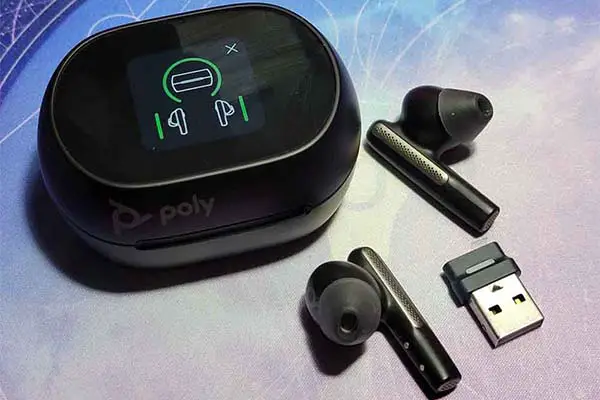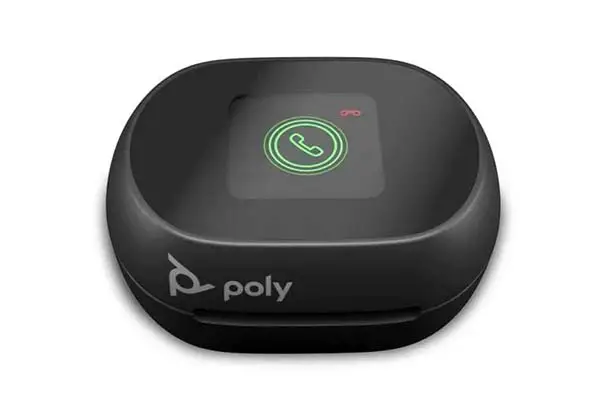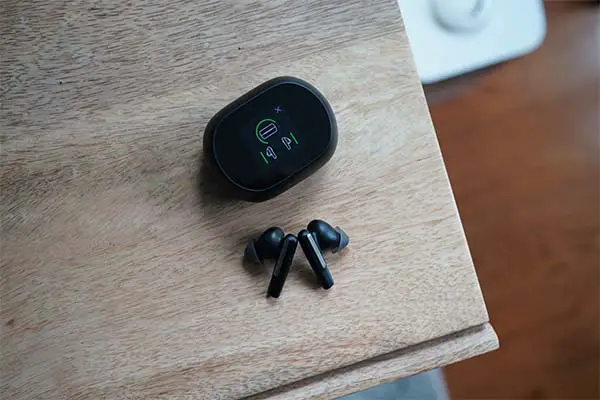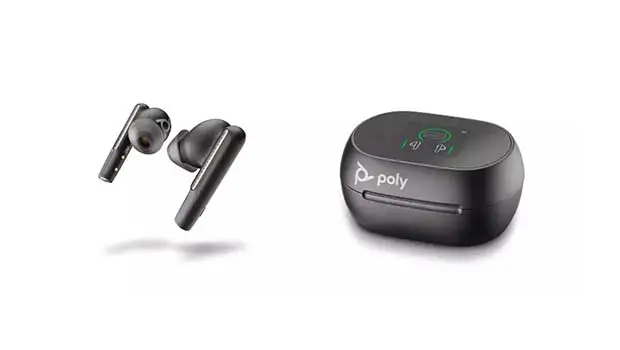Let us address the elephant in the room first: yes, these buds come in a touchscreen charging case. And while that is kind of cool, it also costs $330. Thankfully, the HP Poly Voyager buds come in multiple configurations. So, you can also go for the base model, the Voyager Free 60, which comes with a standard charging case and costs $230, or the Voyager Free 60 UC which costs $280 and offers you a Bluetooth adapter and a travel bag as well. The aforementioned $330 version doesn’t ship with a travel bag but offers the Bluetooth adapter and a 3.5mm headphone jack cable. It also includes the standard array of charging cables and various pairs of ear tips that are present in every configuration.
Looks
Aesthetics-wise, the Poly Voyager buds are pretty basic. They won’t instantly catch your eye or make you take a second glance. However, this isn’t to say that they look third-class in any way. They do exude sophistication and the build quality is pretty nice, too. However, they’re quite sober and plain. Probably a bit too sober for the $330 price tag. If you want the bells and whistles that one would usually expect from a pair of buds that are this pricey, look elsewhere.
One thing’s for sure, though: the buds are very comfortable. I had them plugged in for hours on end and didn’t feel a thing. Some of the most lightweight and ergonomically-designed buds have given me at least a little ear fatigue after a couple of hours, but these buds were an exception. They’re lightweight and stay glued to your ears throughout. I can imagine how convenient an intense workout session with these buds would be. Apart from their snug fit, their IP54 rating makes them an ideal gym companion, too.

The controls on the Poly Voyager buds are pretty straightforward. There’s a button on the stem that handles media play/pause and answers calls. And the stem doubles as a touch-enabled control that lets you handle volume and toggle ANC. I would’ve liked the volume slider to be a little more precise. I found some of my swipes either not giving a response or giving a slightly delayed one. What I liked about the controls is that the stem is long enough for you to comfortably tweak your preferences without any missteps. Another good news is that the controls are all customizable on the Poly Lens app, the buds’ companion software.
Charging Case
The Poly Voyager’s charging case is pretty large. It might be able to fit in a huge pocket but the bulge will look awkward and feel uncomfortable. Its size gives it its heavy weight too. Features-wise, the case is pretty loaded. It allows you to control media playback (play/pause, forward/rewind, volume), check the battery status of each bud and toggle ANC, transparency and speech mode. It hosts a button on its back that powers its screen on/off. I liked the option to turn the screen off; it saved me from a number of mistaps. The button hosts a Type C port right next to it. And there is a slot for the dongle inside the case. Overall, the case is pretty sturdy and robust.
While the touchscreen case is kind of cool and will for sure turn heads, it made me think about whether it’s worth the significant bump in price. Everything that it allows you to control is easily controllable by the buds and your phone, too. It doesn’t provide any extra functionality, and, hence, isn’t convincing enough to make you pay those extra bucks for it. I appreciate the thought that went behind it though, and am looking forward to the company making the concept more useful and exciting in the future.

Performance
The Poly Voyager buds really impressed me with their bass. It is rich and clear but not overdone to the point that it sounds bad. The treble is pretty crisp and bright too. It retains its strength even at higher volumes. The mids sound balanced, too. The orchestra doesn’t sound extremely clustered but I would’ve liked a little more space within the elements. I think the sound lacked just a little imaging and positioning, and the soundstage could have benefitted by being a little wider than it is. For enterprise purposes though, which is what the buds are primarily designed for, the sound is quite good and definitely in accordance with the price.
These buds are excellent at canceling low-frequency sounds. This makes them ideal for your daily commute and flights. The included 3.5mm cable adds to their suitability as your flight companion. They’re pretty good at muting high-frequency sounds as well, but according to my testing, the whir of the fan was muted considerably more than a high-pitched horn. Overall, the ANC is impressive but I couldn’t really tell the difference between its standard and adaptive mode.
There are two transparency modes as well. One lets you listen to ambient sounds while the other, the speech mode, is supposed to turn the volume of your music down so you can focus on the speech of the person you’re talking to. Just like the two ANC modes, I couldn’t really tell the difference between the two transparency modes as well. But both of them were sufficiently good and thankfully didn’t feature the loud hiss a lot of ambient modes feature.
I called my friend with these buds for a quick mic test, and he was stunned. He reported that it sounds like I’m using a dedicated boom mic to talk to him. My voice apparently sounded ‘very crisp and clear’ and there was excellent background noise reduction. It’s safe to say that the Voyagers are perfect for your virtual meetings. Plus, with their Zoom and MS Teams certification (Google Voice and Meet certification in progress), you don’t have to worry about their suitability for your remote work at all.

Battery
The Poly Voyager buds promise up to 16.5 hours of talk time (5.5 hours plus 11 extra hours with the case) and up to 24 hours of music (eight hours plus 16 extra hours with the case) with ANC on. These are pretty good numbers and should last you a couple of days. The charge time on these buds is two hours for the buds and three hours for the case. And wireless Qi charging is supported, so that’s a plus.
There are a couple of other cool features that I’d quickly like to go over. The buds offer mono listening so you could listen to your music with any one of the two buds plugged in. They also support in-ear detection which means your music automatically pauses as soon as you take the buds out of your ears. They offer pretty impressive codec compatibility. You get support for SBC, AAC, AptX and mSBC. With the BT700 Bluetooth dongle, you get LC3 support, too. And lastly, the buds are compatible with both Siri and Google Assistant.
Verdict
All in all, the HP Poly Voyager buds are quite impressive. They offer a comfortable fit, an easy set of controls and a good-looking body. In terms of sound, they sport powerful bass, crisp treble and balanced mids. The ANC and transparency modes are both impressive with low-end noise cancelation being more precise than high-end. Features such as wide codec support, an IP54 rating, and Qi charging make the buds even cooler. The charging case could have been smaller, lighter and more useful, though. At the moment, it isn’t worth its price tag.
Is It Hardcore?
For sure!
I would definitely recommend these buds to you if you’re not on a budget. I didn’t find any flaws in them, they just seem a little pricey considering the charging case – which is marketed as the buds’ unique selling point – isn’t extremely impressive. Overall, the buds check almost every box. If you’re a fan of bass and are looking for great ANC, these are worth going for.


























